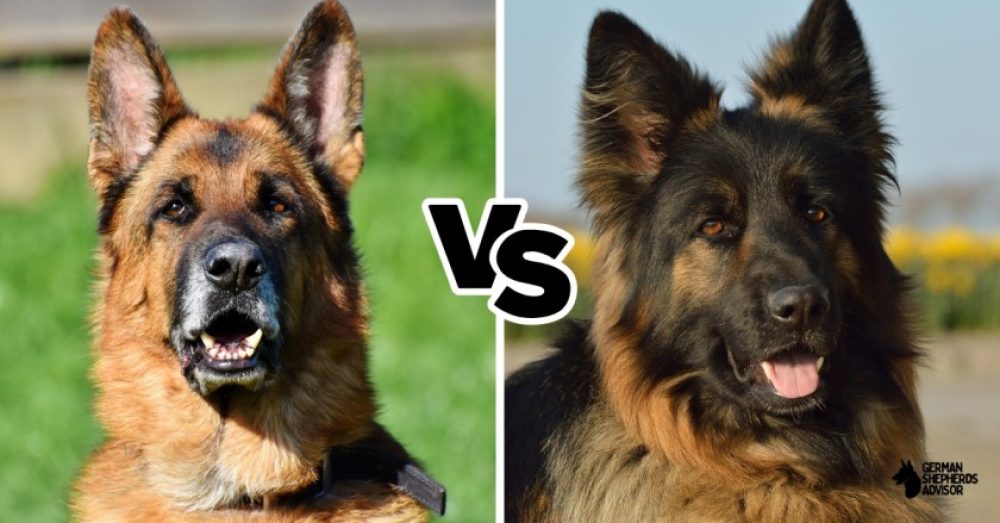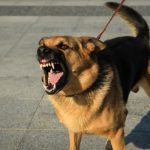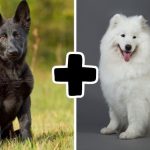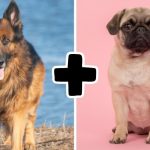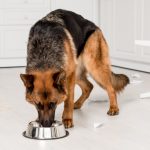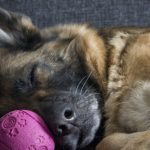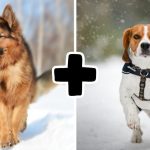With the increased popularity of the German Shepherd Dog, it has become necessary to provide such information as will enable judges and breeders to distinguish between dogs that should properly be shown in classes restricted to German Shepherd Dogs and those that clearly belong in another group.
The correct type for this breed is a strong, well-muscled animal, neither cobby nor svelte. It must be energetic and harmonious. The desired type is one that does not sacrifice strength for speed, or vice versa. It must not look either delicate or cumbersome nor give an impression of raw power without gracefulness. A comparison of the different forms follows:
A dog with short legs appears heavier than it really is; its gait is clumsy because its body swings from side to side and its feet do not reach the ground. A dog with a long, thin body is unbalanced because its long back sways from one side to another when it walks or trots. It appears awkward and tends to tire easily because it has insufficient spring in its step.
Dog showing short legs and a thin body
THE PROPER GERMAN SHEPHERD DOG TEMPERAMENT IS: Self-confident, alert, watchful, intelligent and tractable. Those who own them will testify that they are particularly affectionate dogs which respond well to kindness but are also capable of great tenacity when their duty calls for it-hence their popularity as police dogs The breed’s intelligence makes training easy.
A dog with short legs has a low center of gravity, which makes it less steady on its feet and more likely to fall or develop the swaybacked appearance so often seen in dachshunds. Its long body cannot be supported by normal-length legs without causing shoulder lameness. Dogs with long bodies also suffer because their hindquarters are too high above the ground to give them proper traction when they move; thus, they tend to slide along rather than step quickly forward.
Long bodied dog showing the unbalanced look caused by short leggedness
The German Shepherd Dog should be shown in hard condition – that is, neither fat nor skinny. It should never be cobby, nor svelte like an American show type svelte, but it also should never be beefy. Beefiness is undesirable because many judges automatically place this fault in the same class as short legs-both being an indication of coarseness.
Short legged dog showing typical bad gait
The German Shepherd Dog must always be shown on a loose lead , with his head high, back level and parallel to the ground, front legs reaching well out when moving, docked tail carried naturally. A judge should not disqualify a promising animal because its owner failed to dock or cut off part of its tail or because it has long hair on its ears or body. Such things are unimportant compared to fundamental soundness which can only be achieved by selective breeding for correct type.
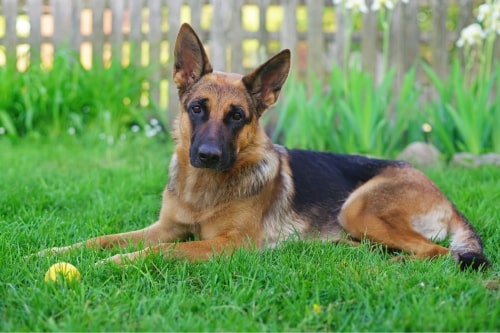
A dog with a long back always has its rear high above the ground – this is caused by short leg
A dog showing typical expression found on German Shepherds, together with correct hair pattern and colors of markings. The breed has an otter-like head, wedge-shaped, with erect ears set high on the skull, almond shaped dark eyes which are deeply set in sockets outlined by black eyeliner, a small black nose (black pigmentation on nose permissible but not desirable), taut lips meeting in front without flews or dewlap.
A scissor bite is preferred; level bite is permissible where necessary because of defective teeth. Only one make and shape of ears should be shown – neither Cropped nor Stiff Ears! Cropped ears are not desirable because they change the shape of the skull, and stiff ears are not desirable because they do not set well.
An American show type svelte compared to a German Show type beefy
The ideal dog has an impressive appearance which is characterized by strength without coarseness, nobility without shyness, straight-forwardness without ill-temper . Its structure reflects good health and physical fitness, with no exaggerated features (unless required for work).
It appears hardy yet never coarse; muscular but agile, capable of enduring great endurance yet never cumbersome. Such dogs give an impression of grandeur that bespeaks alertness at all times; this is particularly apparent when these dogs move. They appear eager to go forward in response to a command, yet they also have a typical breed-type look that is unmistakable.
Short legged dog showing typical bad gait
A German Shepherd Dog which has long hair on its ears or body will not be disqualified because of such things – the only thing important is to avoid exaggerations and proven faults. A judge must remember that he cannot make a good dog from a bad one by merely removing some of its faults. He should concentrate rather on getting as near as possible to the perfect structure and temperament as described above.
Which is better long coat or short coat German shepherd?
If you go on any search engine and type in “German Shepherd” one of the first things that pops up would be a short article stating that German Shepherds shed a lot. This is because it has been rumored for a long time now that longer haired German Shepherds do not shed as much, or even at all, as their shorter haired counter parts.
This may or may not be true, however people continue to perpetuate it without providing proof. So let’s try to look at this from an unbiased perspective shall we? I think most people assume that the reason German Shepherds with long coats don’t shed is because of the length of their coat.
Some will argue that they have double coats while others will say they have coats similar to humans because of the longer hairs. Well, one thing is for sure and that is long haired German Shepherds do not shed as much as short haired ones. But wait a second, why doesn’t this myth have any proof around it? I mean there must be some research done on this right?
Well actually many people say that they know that long haired German Shepherds do not shed because their vet told them so, or someone else with experience owning both said so; however no scientific study has been conducted yet. Let’s take a look at what we do know though:
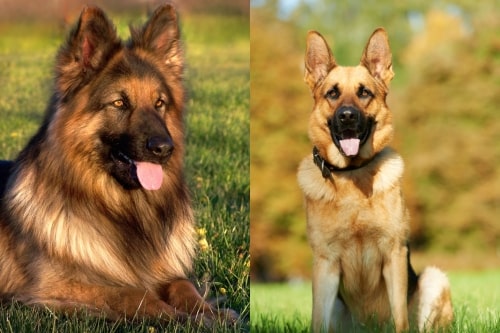
Dog Shedding: The Undercoat and Guard Hairs
All dogs (yes all dogs) shed whether they are long haired or short haired. This is a natural process in which old hairs fall off and new ones grow in. Usually when the new hair grows in they are shorter, thicker and darker than the older guard hairs that were previously there. Our aim is to stop this from happening. So how do we do it?
German Shepherds shed for two reasons, one of them being hormonal changes and the other one being environmental factors. If your German Shepherd is shedding more than usual you might want to consider taking him/her to a vet to be checked out just in case something else is going on with their health rather than just having a bad shedding season.
The best way to understand why dogs shed is by knowing what happens during the actual process. The two layers of the skin are the inner dermis and outer epidermis layers. These “layers” are not visible or easily distinguishable but they produce guard hairs (outer layer) and undercoat (inner layer).
We say that dogs shed because their old coat falls off, but this is not entirely true. In fact what happens is that the dog’s hair production stops for a couple of weeks, which causes all those loose hairs to fall out eventually resulting in shedding. These short new hairs come back at a different time each year depending on daylight hours, hormone levels and other factors influencing hair growth cycle.
Long haired German Shepherds do not have an undercoat but only a single top coat with long thick hair. The reason why we see a longer coat is because of the length and not because of the double coat (inner and outer layer) like other breeds might have.
It has been rumored that long haired German Shepherds do not shed as much or even at all compared to their short haired counterparts. If this was true, then it would mean that any dog with a double coat will shed more than one without such kind of coats. This is why many people claim that this is just a myth while some will say it’s not since we can’t proof anything either way.
What we know so far:
Currently, there is no documented proof regarding whether they do or do not shed at all. So what can we say? This is just another myth that people still believe in without actually knowing the facts. It could be true but let’s not also forget that there are many dogs with long coats who shed just as much as any short coated German Shepherds would.
Maybe the length of the coat makes a difference for some dogs (we will never know until someone conducts tests), however it might not be like this for others. All we can say is that both types of coats require grooming and should be brushed on a regular basis; if you want your dog to have a long haired coat or a short haired one.
If you have both, then the grooming requirements might be different than with just one type of coat so it’s best to plan ahead before deciding on anything. Whether your German Shepherd has long hair will not affect how much they shed in comparison to their shorter coated relatives.
This is another myth used by people who think that this is true but don’t really know why this is so. We’ll never know until someone conducts actual tests on various breeds and compares them all with each other in order to find out whether there are any significant differences between the amount of shedding in every dog regardless of their length or thickness of hair.
For now, let’s just say that it can vary depending on the individual dog and how their hair is naturally going to grow.
Do long haired German Shepherds need haircuts?
A well groomed long haired German Shepherd Dog is a wonderful thing to behold. Their glorious flowing locks are not only gorgeous, but are kept tangle and debris free by their own actions. They spend hours each day carefully grooming themselves and thus they maintain the highest of standards for their coat.
But what about those poor owners who just can’t commit to that level of care? We all know someone who has a GSD and keeps it in a very basic trim or those many people who simply shave down their dog because it’s easier than brushing! Is this really such a bad thing if the alternative is matted fur? Of course not! But will your dog be as healthy as one with longer hair? Let’s take a look…
Top: A GSD in good condition with longer fur. Bottom: The same dog after being shaved. Here is a great photo example of how a brushed, but not shaved dog will look over time compared to one that has been regularly clipped or shaved .
FAQS
The coat looks very different and has perhaps lost some of it’s insulation value after being cut down so short. It is also easier to see where matting may have occurred because there are large patches of missing hair! However you must keep in mind that this particular type of German Shepherd (Groenendael) was bred for’s particular type of long coat.
There are no scientific studies conducted on this particular topic There is no proof yet whether there actually is a difference in how much long haired German Shepherds shed in comparison to short haired ones.

